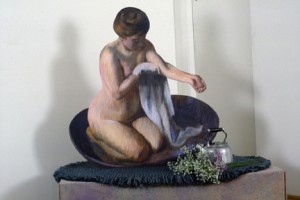Moving
A new group show is up at Viridian Artists, where I’ve recently become a fellow member. We’ve moved to 548 W. 28th St., in the upper region of Chelsea, from a couple blocks away. I joined the gallery this past summer, and I’ve been visiting to help out, attend meetings and generally get to know the other members—Vernita Nemec, Susan Sills, Bob Mielenhausen, and many others, including a couple promising young non-member artists who work at the gallery, Lauren Purje and Rush Wittacre. It’s a great gallery, founded when most of the prominent artist-owned galleries sprang up, in the early 70s, back when the global art world was still anchoring itself in Manhattan. In fact, feminist work by Nemec and Sills from that era was recently acquired by Rowan University, in Glassboro, New Jersey, from the collection of Sylvia Sleigh—and artists represented by the collection were honored in a ceremony to celebrate the acquisition in September.
The Viridian group show, Moving, to inaugurate the new exhibition space is a great overview of the diverse work being done by members—and, to be honest, I was surprised at how strongly I responded to the Susan Sills cutouts when they were already on display at the last group meeting. Sills does life-sized wood cutouts based on works by the Old Masters, and they not only have a wry sense of humor, their craftsmanship is remarkable—you know you aren’t standing before Las Meninas or Degas, yet her ability to evoke the look and spirit of the original is remarkable. I recently had an email discussion with some photographers about ongoing controversies over appropriation of previous work—sparked by ridiculous imputations of plagiarism surrounding Bob Dylan’s artwork, where he bases his imagery on work by earlier artists. I agreed that the mania surrounding intellectual property and plagiarism seems to ignore the centuries-old practice of reworking imagery from earlier masters: “after Delacroix” or “after Rembrandt” was commonly appended to the title of an homage, usually meaning a copy, of some previous tableau. The timing of the discussion was serendipitous since I’d been delighted by Sills’ work during a visit to the gallery a couple weeks ago. In general her cut-outs serve not just as an homage to an earlier painting, but they bring the previous image into three-dimensional space, extended it into a provisional diorama, replete with three-dimensional objects. It’s as if the little infanta in Las Meninas has popped upright from the pages of a book and assumed the dimensions of an actual child. Degas’ bather sits beside a real tea kettle. And Picasso’s mother, teaching a child to walk, leans over her child’s shoulder near a set of square cubes—a baby’s playroom building blocks, which Sills adds to the scene as an amusing way of transforming Cubism into child’s play. What struck me most, though, was the way Sills used the cutout to gently chide Picasso himself—focusing on his repressed gentleness, his fondness for his children, and making that the whole point, ignoring his default persona as the great alpha male of 20th century painting. At the same time, as she pays homage to Picasso’s work, she has picked a painting where Picasso himself was honoring an earlier artist, paying homage to a series of drawings Rembrandt did of women teaching children to stand and walk, many of them in the permanent collection at the Tate. She shows how modern art is as much about tradition as it is about radical invention. By giving these previous masterpieces a three-dimensional power, Sills makes them more inviting, more intimate, a companionable presence in a room—showing how much the work of painters long dead can continue to have a vital presence in the life and work of contemporary artists.

Comments are currently closed.